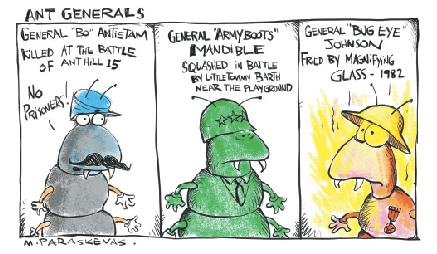Watching Asian Ants Take Over the World

Throughout history, wars between nations have raged. Most have been about conquest in one form or another, although at the present time several center on shaking up the interior of a country until the regime flees. That’s what is going on in Egypt, Afghanistan, Mali and Syria at the present time. On the other hand, if you want a good blow-by-blow fight for a hill or a field, you really have to look at the ant world.
In 2010, sophomore biology students at Stanford University went off on a summertime field trip to Stanford’s Jasper Ridge Biological Preserve nearby, examining ant colonies in various locations in the preserve during a two-month period. They expected to find evidence of the ferocious Argentine ants finishing off the remaining local colonies, all relatively peaceful, that lived in harmony over the centuries.
Earlier studies, not only at Stanford but also all around the world, had confirmed for years that a great many varieties of ants have been routed and killed by huge contingents of Argentine ants AFTER hitching rides aboard freighters to get to new locations. In places like South Africa, the West Coast of America and all around the Mediterranean, the battlefields are littered with dead ants from local tribes who either won’t or can’t fight the hoards of Argentine ants. It’s genocide. The ecology changes after such calamities. Also, some relatively docile smaller bugs called aphids become slaves to the Argentines. The Argentines let them live to suck out a sweet nectar from flowers and then feast on the aphid’s secretions to become big and strong.
What the sophomore students found at Stanford, however, was a complete surprise. The results were reported in the June 7, 2011 edition of Science Daily.
Argentine ants, in short, have been taking over the world. Or have they? Well, the ant world. “No native ant species has been known to withstand their onslaught,” wrote the author. “Until now.”
For the first time, the article states, a native tribe of ants has been using chemical warfare to turn back the Argentine tide. This native tribe, a plucky group known as the winter ants, once attacked by the Argentines, battle them with open mandibles, biting, gaster flexing and chasing, and if that doesn’t get them, they excrete small droplets out of the bottoms of their abdomens at them. The angry Argentines charge, get into the droplets, squirm around and die a horrible death.
“I did not believe it at first,” their teacher biology professor Deborah Gordon told Science Daily. She has been leading these summer forays to the Preserve for more than a decade. “This is a group of ants that does not have a sting and you don’t see them acting aggressively, but the students were able to show very clearly not just that the winter ants are using poison, but when they use it, how they use it and what the impact is.”
One of the students, Leah Kuritzky, did a chemical analysis of the secretion. She and other students obtained samples of it by rounding up winter ants and annoying them with paper clips until the winter ants excreted droplets on the paper clip in an act of self defense.
Part of the excretion is a type of hydrocarbon that gives off an odor that many social insects use to separate friend from foe. The Argentines would have none of it, though. They’d rush in and die. To determine the potency of the poison, the students plucked Argentines out of the grass— hissing and spitting, one supposes—and then introduced them to a petri dish with the excretion in it. Seventy-nine percent died. The poison itself has not been identified.
“One day it was just winter ants going about their business foraging for food and making trails,” Kuritzky said. “And then the next day we came back and the ground was littered with Argentine ants. There were dead ants all around and there was a lot of fighting around the entrances.”
The students did other experiments. They would put one Argentinian into a petri dish with a winter ant and let them have a go at it. There’s no indication of the won-lost record of the various ant gladiators, but Professor Gordon did notice how the winter ants used their poison. “It turns out the winter ants use the secretion only when they are really overwhelmed, so it is probably energetically very expensive for the winter ants to manufacture and use this stuff.”
The winter ants had other advantages. All ants, when the weather gets cold, go into hibernation. The Argentines hibernate from October to April, while the winter ants, stirring awake to start farming in March, have a month’s advantage in seizing new land. The Argentines would arise, see more locals, and just head out to kill them as they always did. But now there was this new biological weapon.
Also, tactically, the winter ants are smarter. They let the Argentines come in, retreating when they come, so the Argentines can happily find the aphids to enslave. When they do, the winter ants pounce. “It looks like the Argentine ants are getting pushed back tree by tree,” Gordon said.
All that was in 2011.
Now, in 2013, there is trouble for the Argentines in an office park in North Carolina, not far from the campus of North Carolina State University at Morrisville. Here, the Argentines are losing to an even more ferocious ant. And us humans, reporting on it, are casting this new tribe as bad guys.
“War of the Ants Intensifies in U.S.” was the headline in The New York Times on February 25.
The battle has been underway at this site at least since 2008, when scientists got interested in it. At that time, 99 percent of the sites in the office park were inhabited by the Argentines; only 9 percent were inhabited by Asian Needle Ants.
Three years later, the Asians were found to have increased their holdings to just under one third of this 112-acre office park. The Argentines, in retreat, still hold two thirds. Unless there’s a new development, the Argentines appear headed for oblivion in this office park.
One might think the Asian Needle Ants, which awaken earlier than Argentine ants and reproduce in early spring, are the same species as the winter ants in California. But they are not. There are photos of the two species. The abdomens of the winter ants are black. The abdomens of the Asian Needle Ants have tiger stripes.
And the Asian Needle Ants don’t fool around with just dropping a puddle of poison in the hopes the Argentines will step into it. They not only fight the Argentines hand-to-hand, they also, if they can, grab them and sting them, which kills them.
The first indication that something was amiss with the Argentines came in 2008, when a researcher named Eleanor Spicer Rice went out into the lawn.
“I was helping someone out with a project observing Argentine ants when I noticed Asian ants hanging around in the area,” she told The New York Times. This was a strange. She’d never heard of Argentines tolerating interlopers.
Pretty soon, the Argentines were not only allowing the interlopers, they were retreating when the interlopers advanced. Apparently, they knew the Asians would have their way with them. And it is not just the Argentines that fear the Asians. The Asians are also feared by humans.
“The danger for humans is that the Asian ants have a venomous sting that can cause weeks of burning and itching,” The New York Times wrote. “Victims who are allergic to the sting can suffer from more serious reactions. The Argentines (on the other hand) “are known for crowding out other small species of plants and lizards, but do not pose a direct threat to humans.”
Should the human pest control people join in the fight against the Asians? It may be too late. The Asians arrived in the United States in the 1930s, at the same time Hitler was plotting to take over the world. We didn’t do anything about Hitler. And we watched the Asians arrive, aboard ships carrying sugar cargos and spread to places like Alabama, New York, Oregon and Virginia and we didn’t do anything about them either at the time.
The only hope now might be to give the Argentines the bomb. Desperate times deserve desperate measures. America has never backed away from a fight.



